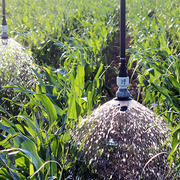
John Maurer has worked for and managed Triple D ranch for over 25 years. This operation is in the high valley of Dyer, a very arid region of Nevada, United States. The climate is windy, with little to no rainfall and very low humidity.
“Efficiency of application is what’s very, very important to our operation,” said Maurer. Before LEPA, “you could see the wind drift on most of the pivots. We just were not getting the water to the crop. The tonnage on the inner spans was great, but it was less on the outer spans. I was even getting runoff on the outer spans of some machines,” he added.
After reading an article about LEPA Close Spacing methods, John tracked down a Senninger rep at the World Ag Expo, who provided him with several options to test in the field. He selected the Senninger® LDN® with the Shroud and a single pad equipped with a bubble insert along with 0,69 bar pressure regulators. He then converted two machines to 76,0 cm spacing between hose drops and 46,0 cm applicator height.
John found that the yield beneath the LDN LEPA bubblers was higher and expanded this installation to other machines.
The following year, Triple D Ranch partnered with Senninger on a new test to learn what was contributing to the improved results. This test included a span-to-span direct comparison measuring yield, water penetration, salinity, soil temperature, total water applied, and evapotranspiration (ET). It allowed for a more direct comparison of moving deflector sprinklers with LEPA applicators within the same field, reducing the variability of different soil types and plant ages.
The test was set-up with three spans of moving deflector sprinklers and four spans of LDN sprinklers with LEPA bubbler pads and Shrouds.
The moving deflector sprinklers were set up with 3 meters spacing, 91 cm above the ground, with 0,69 bar pressure regulators. LEPA applicators were set up with 1 to 0,76-meter spacing, 46 cm above the ground, with 0,69 bar pressure regulators. They balanced flow rates consistent with their pivot span location. They also used two soil moisture probes per pivot – one under the span with moving deflector sprinklers and one under the span with LEPA LDN sprinklers.
The pivot set-up with the LDN and Shroud combination became Triple D Ranch’s top producer. This drove them to set about converting as many machines as they could, even between cuttings.
 “The ground beneath the LEPA bubblers seemed softer,” John said. “We pressed a rod into the soil to compare sprinklers versus bubblers and saw the moisture was deeper beneath the bubblers. We decided to add soil probes to verify what we suspected. Sure enough, the water penetration was deeper beneath the bubblers, and the soil compression was less.”
“The ground beneath the LEPA bubblers seemed softer,” John said. “We pressed a rod into the soil to compare sprinklers versus bubblers and saw the moisture was deeper beneath the bubblers. We decided to add soil probes to verify what we suspected. Sure enough, the water penetration was deeper beneath the bubblers, and the soil compression was less.”
LEPA bubblers not only get more water into the soil, but they also help flush the salts deeper. “With better utilization of water, we are flushing salts. A deeper reservoir of available water encourages new young seedlings to push roots down 0,91 to 1,21 m without the need for ripping,” John added.
John expanded on the benefits he has seen with LEPA irrigation:
Higher Yield – “All fields have shown an increase in yields as well as being uniform and consistent across the entire field. We tracked yield results after four cuttings to compare the results of sprinklers versus bubblers. We were getting more bales and higher tonnage using bubblers.”
Water Savings – “With the windy conditions in the valley, it was evident that the LEPA bubblers were not misting like the other pivots with traditional sprinklers. When the sprinklers are in canopy, you can’t even tell that water is being applied. When we can turn off the pivots in the spring or the fall, where you don’t have the evaporation, we have about a 10 to 15 percent water and energy savings. In the heat of the summer, with our cut cycles, it is evident that we are getting the right amount of water to the crop.”
Reduced Energy Costs – “LEPA Close Spacing bubble systems are very good at getting water into the soil profile. Because of this, the opportunity often arises to shut the water off for several days at a time, particularly in the spring and fall (this is very rare in our desert environment). Anytime you can shut a pump off, the power bill will reflect that action.”
Less Maintenance – “The machine, there’s no need to drain water from gearboxes; the cutter blades.”
Reduced Varmint Damage– “An additional unforeseen benefit was the decline in our gopher population. That was a big deal. Gophers in the field were causing such damage to the field and issues with our pivot performance. I guess you could say bubblers and gophers just don’t get along.”


